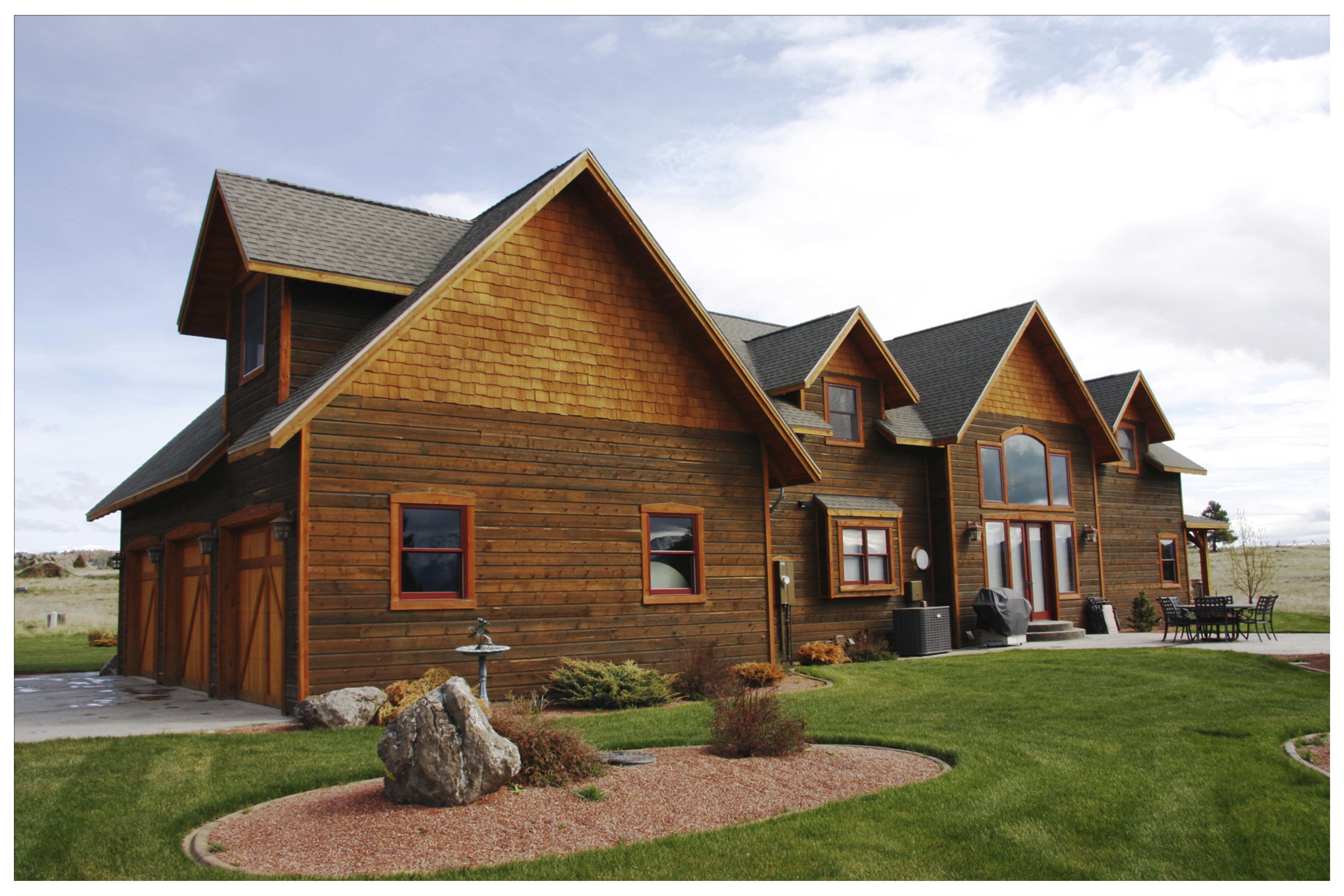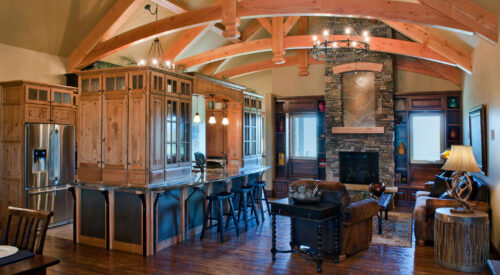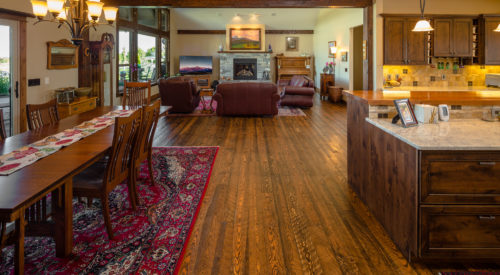
Common Siding Material Comparison
Mar 18, 2020

Choosing a siding material for your home or commercial building is an important choice. As a manufacturer of premium natural wood sidings, we have put together a (mostly) unbiased comparison of using wood as a siding or cladding material relative to other common types. The function of siding is pretty simple; to keep the weather on the outside of our homes. Beyond keeping the weather out, appearance, lifestyle, and the impact on our environment are important factors to consider.
For this post, we are going to look at the most common siding material types in our region: vinyl, wood, and fiber-cement. For each type, we will hit on some high-level pro's and con's; then we will touch on some key installation concepts, issues, and costs. Maintenance is an important factor in your siding choice, so this document looks at the long-term actions and expenses. Finally, we will address the environmental impact of the manufacture and disposal of these common cladding materials.
This overview should give a good basic understanding of these common product materials. Overall, you will find that natural wood materials are a great choice.

Vinyl
Vinyl Siding Pros
Vinyl Siding is made out of a relatively inexpensive material. It is incredibly low-maintenance and requires a limited amount of care throughout the years. It is also insect and rot-resistant and doesn't require treatments to remain so.
Vinyl Siding Cons
Vinyl Siding has somewhat of a plastic, artificial look. Given the strength of vinyl, it can be damaged by impact and may need full sections replaced if broken.
Vinyl Siding Installation
Installation is fairly straight forward; however, it can be challenging in cold weather.
Vinyl Siding Maintenance
This is where vinyl siding really shines; it is incredibly low-maintenance. If you want the absolute lowest amount of maintenance necessary, then vinyl is for you. Most manufacturers recommend washing it once a year; that's about it.

Vinyl Siding Cost
Vinyl siding is very cost-effective. While not the easiest for a DIYer, vinyl is doable. Because of the popularity of vinyl siding, there many qualified contractors and installers available. Professional installation is generally pretty inexpensive.
Environment and Sustainability with Vinyl Siding
Vinyl siding gets pretty low marks for environmental friendliness. The manufacturing process of polyvinyl chloride (PVC) is very energy-intensive, and there are concerns about the release of chemicals into the atmosphere. While it is technically recyclable, it is challenging to find an organization that will accept PVC siding to be remanufactured or repurposed. On the environmental upside, vinyl siding is very light, making it relatively energy efficient to transport.

Natural, Sustainable Wood Siding
Natural Wood Siding Pros
No one can deny the beautiful appearance of natural wood. There is a reason vinyl, fiber-cement board, and even metal sidings try to approximate a wood look. Coming in with a moderate cost, relative to other options; natural wood siding is relatively easy to install and has lower maintenance options.
Natural Wood Siding Cons
One of the downsides of natural wood siding is that it must be maintained to keep its stunning beauty. It is susceptible to warping, checking, and rot, as well as damage from insects and those stinking woodpeckers.
Sustainable Wood Siding Installation
Installation of wood siding is easy enough to be handled by pretty much any DIY'er. There are many excellent commercial installers; however, it is best to educate yourself on installation best practices to ensure that your contractor is adhering to them.
Sustainable Wood Siding Maintenance
Proper maintenance of wood siding is critical to achieving the 50+ year life expectancy your wood siding is capable of. There are lower maintenance solutions for wood siding, but to maximize the life of your siding, you need to use a surface treatment to inhibit rot. There are options for treatments to keep your siding in the best shape possible.
Two treatments for natural siding are non-toxic and water-borne. Lifetime® and ECO wood treatments are two of the more popular products in this market space. A less common alternative, due to its highly labor-intensive application, is the visually stunning Japanese technique called "Shou Sugi Ban." Shou Sugi Ban involves burning the exposed surfaces of wood and then covering it with natural oil. While Shou Sugi Ban is more difficult in the application, it is lower maintenance between treatments.
None of these approaches provide UV protection. Over time, your wood siding will achieve an aged look. If you prefer the look of new wood, you will have to use a covering that provides UV protection in the maintenance of your siding. Marks Lumber recommends the Perma-Chink System for maximum protection and relatively low interval maintenance. You will need to reapply the clear coat on this as necessary to keep it looking its best. In general, every couple of years is consistent enough to preserve your wood siding.
If you are looking to maintain a new wood look, you will need to schedule maintenance on your siding. The process is generally required every 2 to 5 years, depending on the technology you choose. We will cover this more in detail in the next section.

Wood Siding Costs
Wood siding can be more cost effective than you might think. Material for wood siding is generally in the $2.00 to $4.00 per sq ft range for standard softwood sidings. Marks Lumber sidings fit in that range with rustic grade materials for around $2.00 per sq ft, standard shiplap style sidings are just under $3.00 per sq ft, and fancier hand-hewn textured beveled siding comes in just over $4.00. Installation costs for siding, not including finishing, should also be around $2.00 to $4.00 per sq ft.
Coatings and coverings are a significant cost for natural wood, both upfront and in maintenance. This should be one of the considerations when choosing wood siding. The lowest cost option is to use a wood treatment like Lifetime®, which can be applied, labor included, for less than $.70 per sq ft. Quality transparent or semi-transparent stains can easily run over $2.50 sq ft with labor.
If you want natural, beautiful wood siding, the best way to manage your costs is to arrive at a price per square ft and decide what material fits within that budget. This is an area where we can assist you with, and will be happy to help you estimate costs. Contact us today, and we can talk more about it.
Environmental Impact of Wood Siding
Wood siding products can get extremely high marks for environmental friendliness. First of all, wood siding can be manufactured from a variety of sources, but we prefer to use sustainably harvested trees. Effective management of lumber, logging, and forestry provides premium wildlife habitats and maximum tree growth, which in turn offers elevated carbon sequestration, and a variety of recreation opportunities.

Fiber-cement
Fiber-cement Siding Pros
Fiber-cement is an older technology that is always being updated. Fiber-cement cladding lasts a very long-time, often over 50 years. Fiber-cement boards are considered to offer a better look than vinyl and can be painted to suit a particular taste. There are a variety of patterns you can choose from in going this way with your siding choice. There are also versions of Fiber-cement boards that are stained in the process of making them. These options are harder to paint, but the dyed colors added to the boards in the manufacturing process wear better than painted materials.
Fiber-cement Siding Cons
One of the downsides of Fiber-cement boards is that the installation is somewhat more expensive than vinyl and wood. Another low point, in comparison to vinyl, is that for that extra cost, you are not getting a product that requires as little maintenance as the vinyl siding.
Fiber-cement Installation
Installation is generally considered to be far more complicated than vinyl siding and most wood sidings. For both homeowners and professionals, extra care must be taken when handling fiber-cement board as it is less flexible, to avoid breaking it during install. Also, precautions must be taken to wear simple PPE to protect from dust produced by cutting the material.
Fiber-cement Maintenance
Maintenance for fiber-cement siding is less expensive and time consuming than wood, but can be greater than vinyl over the long term. Most pre-finished fiber-cement siding is warranted for color for the 15 years after installation. Then it requires regular painting, generally every 3-5 years. Like all other sidings, it benefits from being washed at least annually!

Fiber-cement Costs
Installation cost is somewhat higher than vinyl and often more than wood siding. There is a wide range of prices for the fiber-cement board. Materials can run from around $1.80 to over $5.00 per sq ft. The installation will generally run between $4.00 and $6.00 per sq ft.
Environmental Impact of Fiber-cement
The environmental impact of fiber-cement siding varies a great deal depending on the type. Many types of fiber-cement contain some wood-pulp waste, which provides some carbon sequestration. The manufacturing process is energy intensive but produces little pollution other than carbon. Also, it requires more energy to transport than other sidings, but if properly maintained, has a lifespan that can last 50+ years.

Summary
Vinyl, wood, and fiber-cement board are all acceptable options to protect your building investment. As with all types of siding, especially fiber-cement board and wood, if you want to minimize the environmental impact of your siding, do the regular maintenance! It's good for the planet and good for your pocketbook.
As the most widely used types of siding, natural wood, vinyl, and fiber-cement board all have strengths and weaknesses, and provide a wide range of excellent options to keep the weather out of buildings. At the end of the day, natural wood siding offers durable, environmentally friendly protection for your home or business, at a reasonable price.
If you are searching for what siding product is right for you, contact us at Marks Lumber, and we can help you make the right decision for you and your home!
Resources
Angie's List: The Pros and Cons of Different House Siding
Siding Estimator: Green Siding Options
Minnesota Sustainable Housing Initiative: Cladding
Roofing Calculator: Best Types of House Siding: Top Brands, Costs, Pros & Cons
Allura: 20 Benefits of Fiber Cement Siding for Builders, Contractors, and Homeowners
Learn More About Our 105 Siding/Channel Rustic Products
View 105 Siding/Channel Rustic ProductsOther Posts
Jan
2023

Five Timeless Interior Design Trends
When it comes to interior design, it may feel daunting to keep up with the ever-evolving trends that come with each passing season. Well, we're here t...
Jan
2023

Lumber Textures Defined
Lumber comes with the benefit of versatility. One of the simplest ways to create intrigue with lumber products is by using different textures. Circle ...
Dec
2022
Tips for Using Radiant Heating with Wood Floors
One of the best parts of living in Montana is experiencing all the seasons – and yes, we include wintertime. However, as much as we may love the...